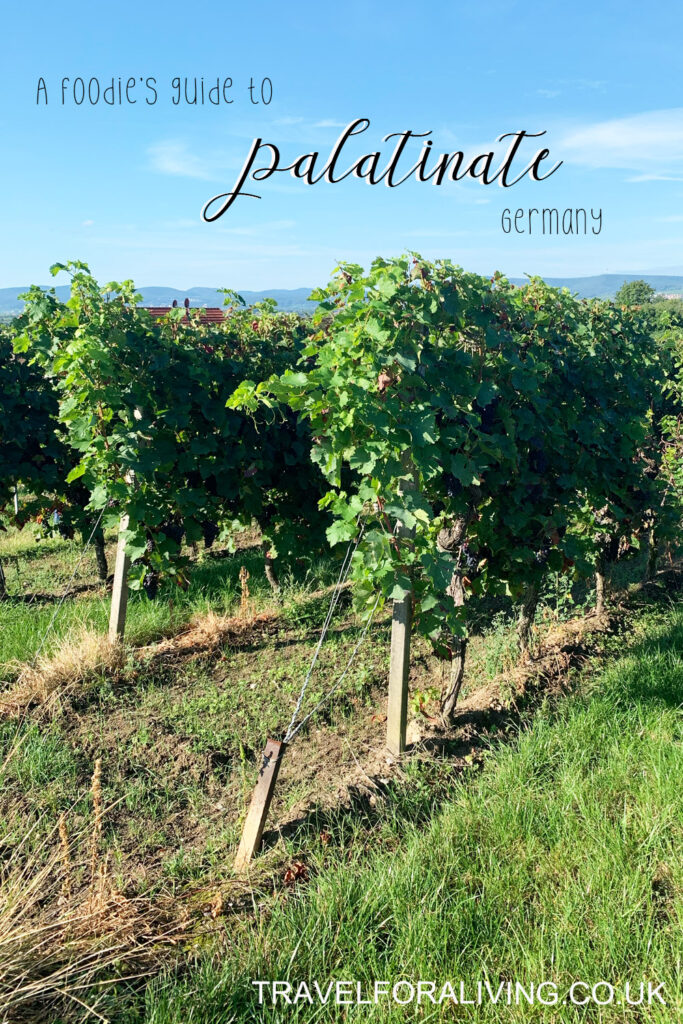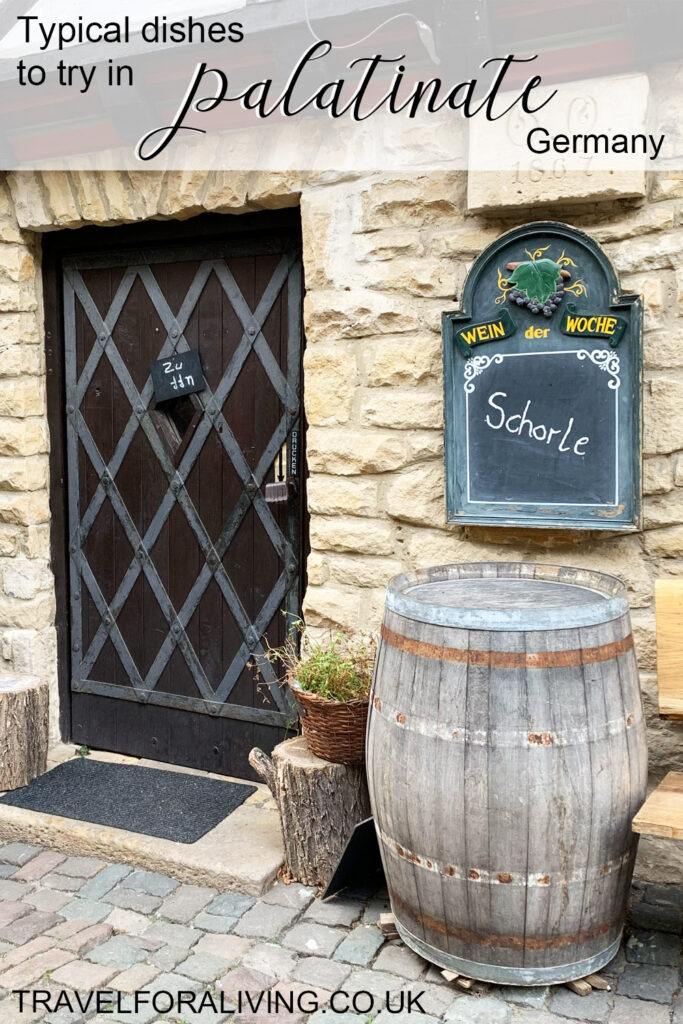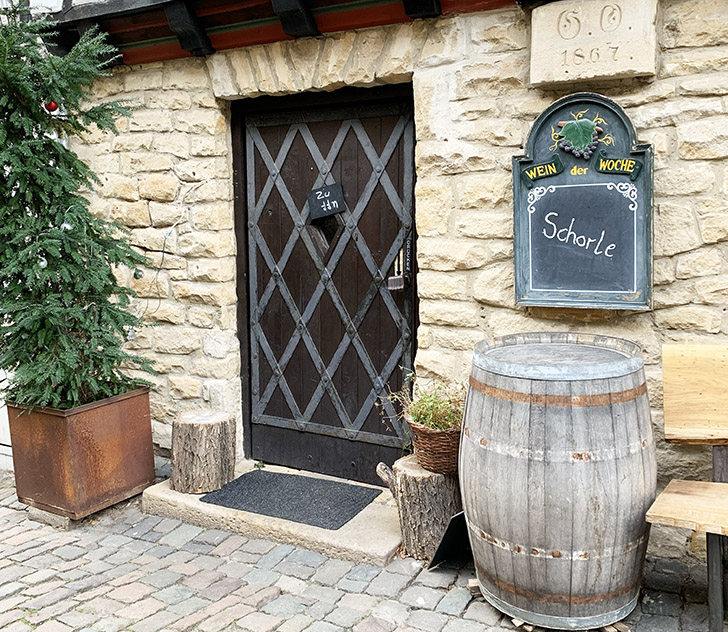Since I’ve decided to finally share a bit about the region I grew up in, how about I not only tell you all the things to do, but also what to eat (and drink) when visiting Palatinate. After all, there are some typical Palatinate dishes that you should definitely try when visiting.
Full disclosure: Whilst the food is great in Palatinate, you might struggle a little with specific dietary requirements. Nowadays, most restaurants will at least offer you a vegetarian option (believe me, this is not something you can always take for granted in the region, but it has improved massively in the last 20 years). But finding vegan Palatinate dishes? That might be a little more difficult. Not saying it is completely impossible. But truth to be told, I would struggle recommending a vegan restaurant (or a typical Palatinate dish suitable for vegans).
I don’t know about you. But if I visit a new place, I do want to try some regional dishes and get an idea of what the local cuisine is like. A passion Mr T and I definitely share. Partly because hubby is a trained chef after all, even if nowadays he doesn’t work in a restaurant anymore. But also just because we both love eating.
So, let’s get started with my recommendations which typical Palatinate dishes you should try.
Zwiebelkuchen & neuer Wein (Onion cake + new wine)
I know this might sound odd I promise to tell you what to eat in Palatinate. Yet my first recommendation is a drink, not food. But trust me, you don’t want to miss out here.
Onion cake and new wine is a typical Palatinate dish in autumn once the wine harvest has started. When visiting from early September to mid-October, you will see signs advertising new wine (also called Federweisser) outside loads of wineries in Palatinate.
New wine is a very young wine that has only just started fermenting. It doesn’t quite look like wine yet. Instead, the fermenting yeast makes the liquid cloudy. It will still be fairly sweet, almost like grape juice, with just a little bit of alcohol. The longer it ferments, the stronger it gets. Because of the sweetness it is easy to underestimate the amount of alcohol you are consuming. Don’t be fooled.
New wine has a short shelf life and will only keep for a couple of days. Unfortunately, it also doesn’t travel very well, as you can’t close the bottles or containers completely. Since the wine is still fermenting, the gasses need to escape. Making it difficult to transport (definitely not possible, if you are travelling by plane).

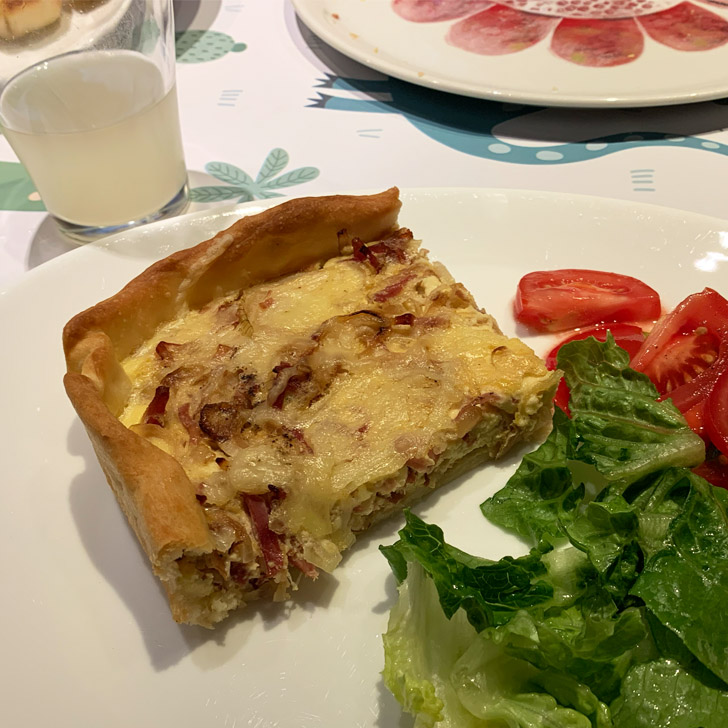
I don’t always make it to Palatinate in time for the new wine, but if I do, I will pop into one of our local wineries and get a litre or two.
Zwiebelkuchen (onion cake) is a savoury yeast dough pie, deep filled with sauteed onions, caraway seeds, cream and diced bacon. It goes great with new wine (well, with ‘old’ wine as well, to be honest).
If you have a delicate stomach, be careful with this typical Palatinate dish. As Zwiebelkuchen and new wine can definitely be a very explosive combination. It tastes great, but you’ll live to regret it later.
What to eat in Palatinate: Pfälzer Teller (Palatinate Plate)
If you are a vegetarian, you might want to skip this section. As the Pfälzer Teller is definitely only suitable for carnivores and there are no vegetarian (let alone vegan) options.
The Pfälzer Teller (Palatinate Plate) combines several regional delicacies. The main items on the plate are:
- Pfälzer Bratwurst (coarser than a standard German bratwurst)
- Saumagen (a pig’s stomach filled with lean meat, potatoes, onions and spices, cut into thick slices and grilled)
- Leberknödel (liver dumplings)
These meats will be accompanied by sauerkraut and a dark rye bread or mashed potatoes. And finished off with mustard or onion gravy.
OK, reading this, the Pfälzer Teller might not be for everyone. But don’t diss it until you’ve tried it. It is one of the typical Palatinate dishes I miss the most living abroad. And one I will happily pick whenever eating out in Palatinate. The Pfälzer Teller was even part of our wedding menu, that is how much Mr T and I like it.
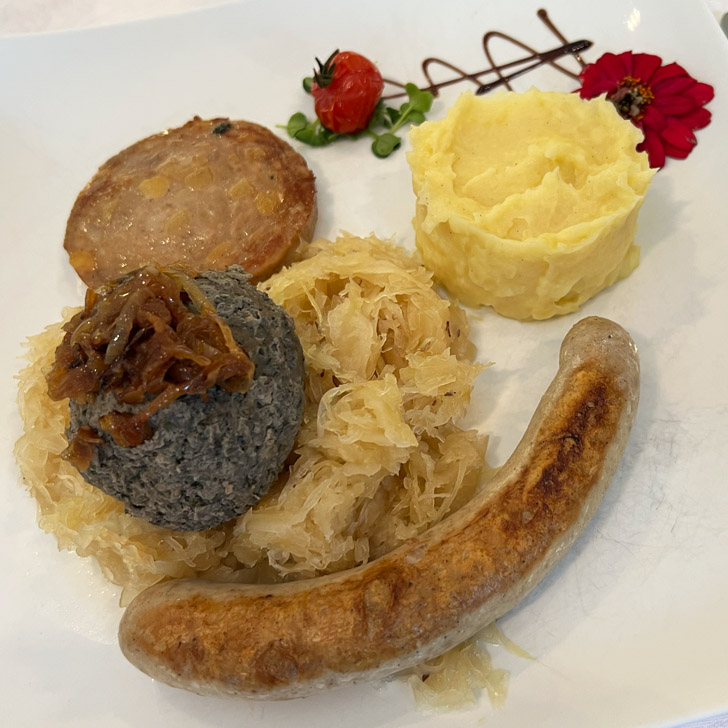
Typical Palatinate dishes: Dampfnudeln (steamed dumplings) with wine sauce
After the rather hearty Pfälzer Teller, lets continue with something for the sweet tooth. Dampfnudeln (literally translates as ‘steamed noodles’) are yeast dumplings that are prepared in a lidded pan with water and salt. The steam will let them rise, until they completely fill the pan. And once the water has evaporated, the salt will create a crust at the bottom of the dumpling. For an extra treat, hope for double baked Dampfnudeln (which will have a salted crust top and bottom).
The Dampfnudel is served hot with either vanilla custard or wine sauce. I would definitely recommend the wine sauce. Which is also a vanilla sauce but prepared with white wine, usually Riesling.
Although the Dampfnudel is a sweet rather than savoury dish, I would class it as a main dish, not a dessert.
If you want to try making Dampfnudeln yourself, here is my mother-in-law’s recipe (German only, I’m afraid).
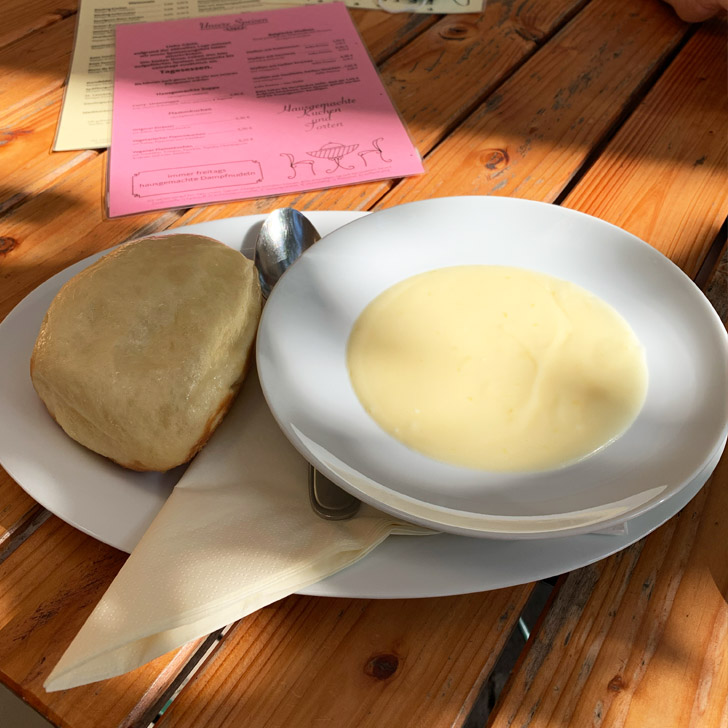
Food to try in Palatinate: Hausmacher
Another dish completely unsuitable for vegetarians and vegans. Sorry folks.
Hausmacher (meaning home-made) refers to a selection of different meats and sausages, typically canned and cooked, making them long lasting. The most common would be liver sausage, blood sausage and bratwurst meat.
There are two traditional ways of serving Hausmacher.
With bread, mustard and gherkins. Or with boiled potatoes and white cheese (quark) with herbs.
Personally, I like it both ways (or just a combination of all).
The good thing about Hausmacher in a tin? It does not require any chilling and has a long shelf life. Perfect to take home (believe me, I know what I am talking about, we regularly stock up on Hausmacher when visiting Palatinate).
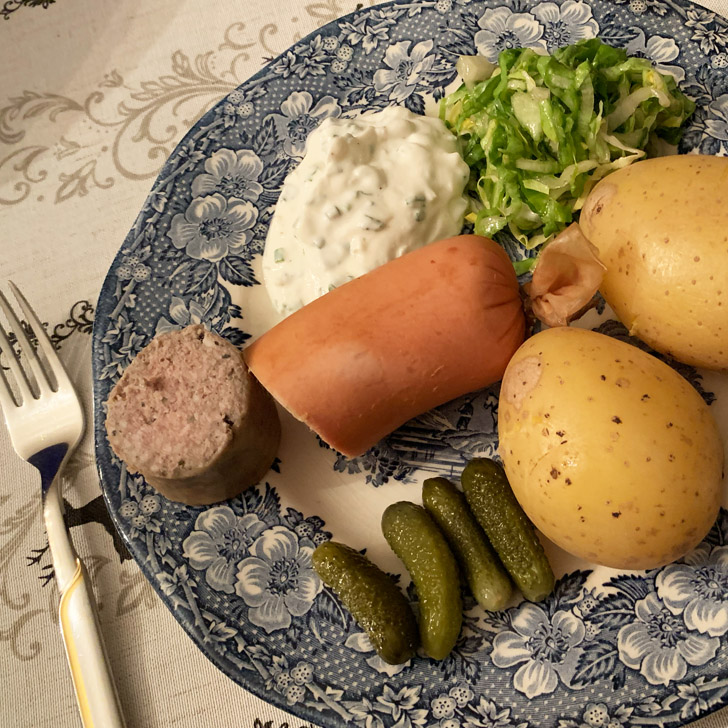
Typical dishes in Palatinate: Grumbeersupp (Potato Soup)
Palatinate doesn’t just grow wine. You will also find loads of vegetables and fruits here. So, it is to be expected that some of those produce also feature in the regional dishes. Potatoes are a big part of the Palatinate cuisine (or German cuisine in general). A Palatinate potato soup contains potatoes (obviously), boiled in a beef broth and enriched with cream. It is traditionally served with Dampfnudeln or Quetschekuche. Which brings us to the next of our typical Palatinate dishes.
What to eat in Palatinate: Quetschekuche (plum cake)
Plums in Palatinate will be ripe from around mid-August. Therefore, Quetschekuche is another dish typically available in autumn, together with the new wine and the onion cake.
Plum cake is a yeast dough, topped with halved plums, a sprinkle of sugar and cinnamon and then all baked until golden.
Gequellte unn weisser Käs (potatoes with white cheese)
Not sure this is a dish you will find in restaurants too often. More one that you would make at home. But definitely a very typical Palatinate dish.
The potatoes will be boiled until soft, unpeeled and uncut.
Then served with ‘white cheese’, a quark with diced onions, chives, pepper and paprika.
Rieslingschorle
Let’s finish my list of typical Palatinate dishes with another drink rather than a food.
Rieslingschorle is a white wine spritzer (so Riesling mixed with sparkling water), that will typically be served in a half litre glass (called a Schoppe in Palatinate).
The most common Schorle would be ‘Sauer’ (sour), so mixed with sparkling water. But you might sometimes read ‘Süsse (sweet) Rieslingschorle’ on the menu, which would be Riesling mixed with lemonade instead of water.
And it isn’t just Riesling you can get as a Schorle. Most places will prepare you a Schorle from any white or rose wine they serve.

There you have it. My list of typical Palatinate dishes you should try when you visit the area. And don’t forget to come back and tell me which one was your favourite.
